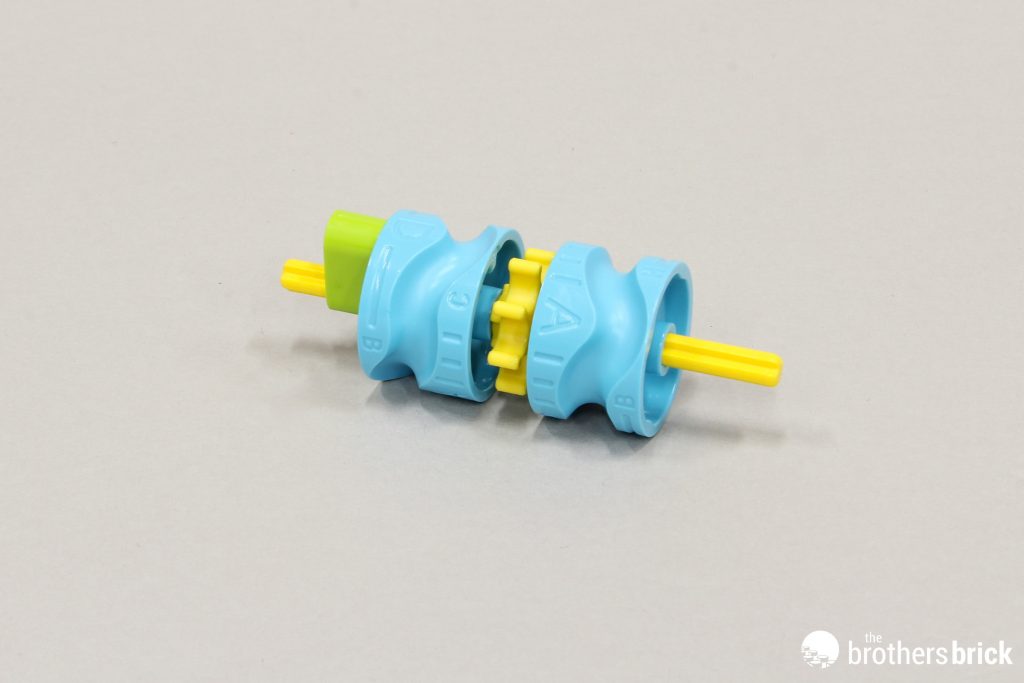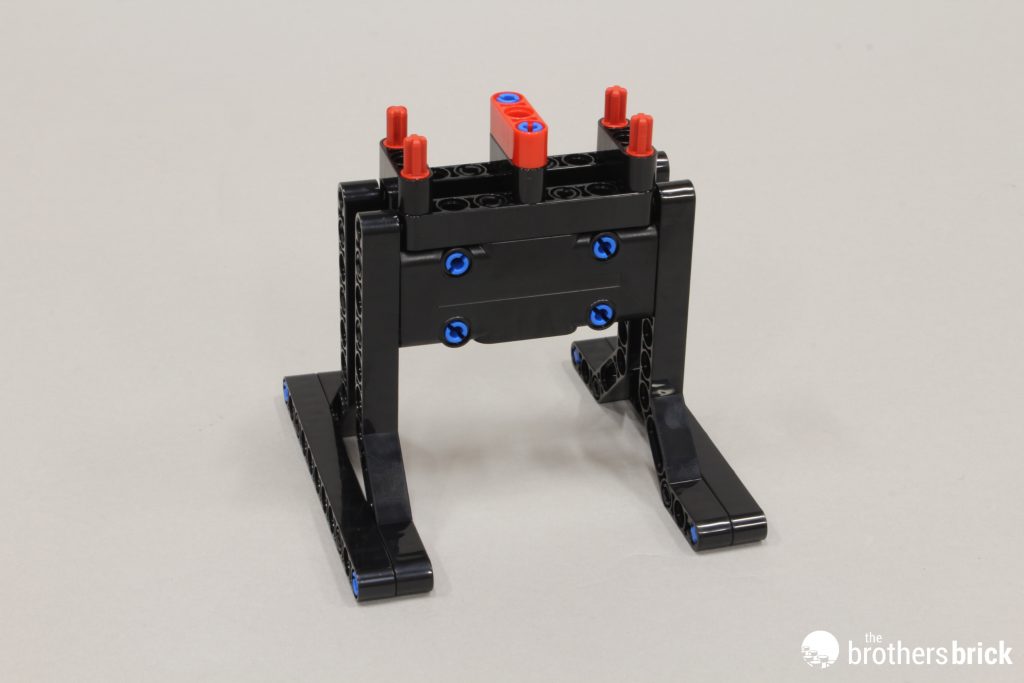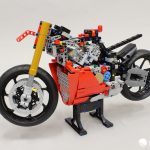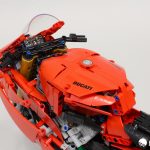Way back in 2020, LEGO produced 42107 Technic Ducati Panigale V4 R. At the time it was special because it was the first Technic motorcycle with a gearbox. Four years later, we’re being treated with LEGO Technic 42202 Ducati Panigale V4 S Motorcycle, the latest superbike in the Ducati line. At first glance, apart from the body and color, it seems like it will be pretty similar to the other large-scale Technic motorcycles. Join us as we take a closer look. The 1,603-piece Panigale V4 S is currently available as a pre-order to LEGO Insiders, and will be more widely available starting January 1st for US $199.99 | CAN $259.99 | UK £169.99.
The LEGO Group provided The Brothers Brick with an early copy of this set for review. Providing TBB with products for review guarantees neither coverage nor positive reviews.
Unboxing the parts, instructions, and sticker sheet
The box is the typical fare, closely resembling the other recent motorcycles from the Technic line with that lovely black background and matching red banding. It has the same 1:5 scale denotation as the others, as well as similar insets on the back featuring the size, play feature, and comparisons between the model and the real thing. Like the rest of the recent 18+ sets, the box is two pieces (lidded).
Inside we have twelve paper bags numbered 1-12. There is also a clear polybag with the typical random large pieces, and the loose wheels and tires. This is the first time that I’ve seen the instructions and sticker sheet come in a paper wrapper versus a cardboard sleeve. It’s not quite as protected as the cardboard, but the paper is heavy and it seems fine.
Opening that wrapper, we find the thick booklet and an average-sized sticker sheet. Inside, the first several pages match that of the rest of the 18+ sets. If you’re new here, that includes notes about and pictures of both the model and the real thing, comments from the LEGO designer, etc. In this case we also have a lovely timeline of the history of the Ducati motorcycle.
The build
Jumping into our first bag of the set, I like to take a moment and assess the lovely array of parts that make up the mechanics. Some of the gears have been around for ages, while some parts are quite new, only showing up in a couple of sets thus far. I won’t bore you with the nitty-gritty of every part, but pay attention to the non-gear elements and the yellow ratchet gear.
Things develop rather quickly, with most of those gears going on right away. It looks a bit complicated, but the magic happens with the orange changeover forks that are clipped to the driving rings.
A couple of additional important components are the shifting paddle and the changeover cylinders.
Ball pins attached to the forks sit within the grooves of the cylinders, and with the help of the paddle, ratchet gear, and rubber bands, we have a near-functional shifting mechanism.
But slow your roll, friends! As tempting as it is to play with it at this point, it still needs some more structural help to work consistently. Perhaps you can see from the GIF below that it’s a bit of a struggle to get it to engage properly. If it feels like it’s not working quite right, don’t panic. Wait for the next bag.
With the next bag, we give it that much-needed stability, along with the frame to build the rest of the bike onto.
It may be a bit hard to tell the difference in the GIFs, but if you look closely in the center, the shifting is much smoother now.
Next we have the fork pins used to create the updated-style piston. These first showed up earlier this year in the Kawasaki Ninja bike and the Koenigsegg Jesko Absolut Hypercars, and have been seen a couple more times since.
I realized after uploading these photos that I forgot to grab a shot of the crank disks, so please accept this one from the Kawasaki review. Do note that this kit only comes with two, as opposed to the four in the Kawasaki. Also note that the axle holes are off-center, which creates the piston-effect.
Some interesting and complicated-looking building make up the top of the engine, topped with the tried-and-true engine cylinders.
If you look closely at the last picture, you can just make out the piston forks clipped to the crank disks. Pulling the chain sets all four into rhythmic motion.
Next up we build the stand that the bike will sit on for the rest of the build process, as well as later display.
Moving right along, we tack on some more of the skeletal structure of the bike, as well as the giant suspension spring that sits at the back.
The belly of the motorcycle comes next, with our first bits of paneling and sticker.
The flashy front shock absorbers come next, as well as the skeletal components for the rear wheel.
It’s really starting to look like a bike now, as we slap on those awesome wheels and tires, complete with dual-molded disk breaks.
A word of warning: make sure you have the tires mounted on the wheels in the right direction! They are a royal pain to take off and put back on correctly!
Driving rings represent exhaust outlets in front of the rear tire.
Next, the guard over the front tire is installed. It’s cobbled together and not the most attractive thing in the world, but I guess there aren’t a lot of equivalent LEGO options without a new mold.
We follow that up with the seat, which looks okay I guess. Obviously not as slick as the real thing, but not too bad, either.
Finally we’re at the stage where we add all the paneling that makes this clearly a Ducati. Several of these parts are new or rare in red, or even entirely new inverted panel molds.
From the top angle, you can see the inverted panels a bit better, as well as the stickered instrument display tile.
A custom-molded windscreen comes next. And… um… it kind of misses the mark. I mean, the windscreen seems to be the appropriate shape, but the gap between it and the paneling around it is pretty ugly. Underneath, there should be a black panel. Instead, we get a single 1×1 black tile for the Ducati logo, which isn’t even printed.
Up top is the bulbous fuel tank and some pretty standard handlebars. I almost critiqued the absence of the mirror lights, but reminded myself that this is the racing version.
And that’s it. We’re done! I’ll save the final pics for the next section. I have to say, though, the final step is placing the giant information sticker on the 8×16 tile. I couldn’t get a good picture, but this was a disaster. I’m generally pretty good at applying these stickers, but this time it was filled with bubbles, and every attempt I made to fix it simply made it worse. Most of the time I try to give stickers the benefit of the doubt, but needless to say that bit of frustration put a sour taste in my mouth.
The completed model
The finished motorcycle certainly looks like a Ducati. In some ways it does a good job of executing the look. In other ways it looks a little choppy. It definitely looks better than the last Ducati, but it certainly should be with 40% more parts and a large library of new molds. One thing I do like is that the majority of those unsightly blue pins have been covered up – albeit not completely.
Some people probably won’t like the look of the exposed gears – especially the azure one in the middle. Personally, I like the ability to see the mechanisms. Overall, this feature works smoothly most of the time, but can be a bit clunky. This seems to be true for most if not all of similar LEGO gearboxes.
There’s also lots of play in the suspension, which may or my not be accurate, but it’s sure fun to play with! This is also something that is pretty consistent with the other cycles.
Conclusions and recommendations
In some ways this is very much like the other recent Technic motorcycles. It’s roughly the same scale, and similar stuff takes place inside the body. But I was surprised to find that it is indeed its own unique build experience, so that was a plus. As the racing model, I do find it odd that it doesn’t include the same stand as the LEGO Technic 42130 BMW motorcycle.
If you’re someone who likes to collect the Technic motorcycles, it’s probably worth adding to your collection. If you’re a big Ducati fan, it also might be worth adding to your (or your favorite person’s) collection, but you might find yourself a bit disappointed with some of the aesthetics. If you’re considering this as your first Technic purchase, maybe try something a little less gear-intensive first.
LEGO Technic 42202 Ducati Panigale V4 S Motorcycle is currently available to pre-order for LEGO Insiders. It will be more widely available starting January 1st, retailing for US $199.99 | CAN $259.99 | UK £169.99. You may also be able to find it from 3rd party retailers such as Amazon and eBay.
The LEGO Group provided The Brothers Brick with an early copy of this set for review. Providing TBB with products for review guarantees neither coverage nor positive reviews.































































































